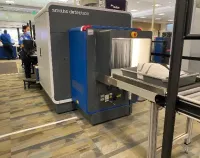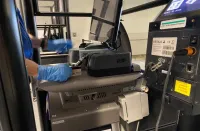
PALM SPRINGS, California - The Transportation Security Administration (TSA) anticipates a record number of people will be screened through the security checkpoints at Palm Springs International Airport (PSP) this summer, surpassing 2019, pre-pandemic volumes.
Nationwide since June 1, TSA screened an average of 2.27 million people per day, which is a 16% increase over last year’s volumes, but down 11% from pre-pandemic 2019 levels when TSA was screening approximately 2.56 million people on average per day. So far in July, TSA saw a surge in the number if people screened around the Fourth of July weekend and anticipates sustained travel volumes throughout the summer.
As air travel recovered nationally over the past few months, TSA at PSP has seen steady travel volumes. PSP’s busiest time of year is the winter months when the Coachella Valley’s tourism season is in full swing. During the summer months, PSP’s consistent passenger volumes are driven by the addition of more airlines and flights than previous summers.
In March 2022, which is the busiest month so far this year, TSA screened approximately 207,000 people through the security checkpoint at PSP. That was a five percent increase over 2019 pre-pandemic volumes at PSP when approximately 197,000 people were screened. In March 2021, TSA screened about 119,000 people.
More recently, in June 2022, TSA screened approximately 75,500 people, up from about 68,000 in June 2021. This compares to 2019 when TSA screened nearly 57,000 people during the month of June.
“No matter the season, TSA at Palm Springs International Airport is on the job and ready to ensure the safety and security of tourists and residents who are lucky enough to spend time in the Coachella Valley. Whether it is a peak travel time or a slower period, we encourage all passengers to come to the security checkpoint early and prepared,” said TSA Federal Security Director Keith Jeffries who oversees security operations at PSP.
Flight departure schedules are determined by the airlines. When there is a concentrated number of flight departures over a short period of time, there will be intervals when the number of departing passengers may exceed the capacity of the TSA security checkpoint for a period of time.
TSA continues to staff the security checkpoint based on the number of travelers projected to depart the airport at various times during the day. The busiest times at the checkpoint are 10 a.m. to 1 p.m. The busiest days to travel locally are Fridays as well as Sundays and Mondays.
TSA strives to get travelers through the general security screening process in less than 30 minutes and through TSA PreCheck screening in less than 10 minutes. With this in mind, travelers should know that there is no substitute for arriving early and prepared for the air travel experience, regardless of what airport you are departing from.
Security technologies
At PSP, TSA is using two state-of-the-art security technologies in the checkpoint. The first, Credential Authentication Technology (CAT), can be seen at the entrance to the security checkpoint. CAT units are programmed to confirm the validity of a traveler’s photo identification and confirm flight information in real-time by matching the passenger’s biographical information from the photo ID against the Secure Flight database.
When travelers approach the travel document checking podium and CAT is in use, the TSA officer will insert the photo ID into the CAT unit. There is no need for a boarding pass at this point since the Secure Flight database contains the names and flight details for people ticketed to travel in the next 24 hours. CAT units are also designed to identify fraudulent documents and those that have been tampered with.
The second technology is a computed tomography (CT) scanner to screen travelers’ carry-on luggage in the security checkpoint. This type of scanner provides advanced explosives detection capabilities by applying a sophisticated algorithm to generate a 3-D image of the contents of the carry-on bag. A security screening officer can manipulate the 3-D X-ray image on-screen to allow for a better view of the bag’s contents, ultimately reducing the number of bag checks that are required.
When a carry-on bag is screened through a CT scanner, travelers can leave everything in their carry-on bag, including electronics larger than a cell phone and food. Another requirement of the CT scanner system is every carry-on item must be placed in a bin for screening.
Travel advice
Travelers have the ability to impact the efficiency of the screening process. Because there is no substitute for beginning to prepare for your travels prior to leaving home and arriving at the airport, TSA encourages travelers to follow the tips below.
Listen for guidance from TSA officers. Some people may not have traveled recently, so it is important to listen to the direction provided in the security checkpoint. There may be information on new technologies that help reduce touchpoints and make for a more streamlined and convenient passenger experience, so listen up!
Empty your pockets prior to arriving in the checkpoint. Place wallets, phones, keys, sunglasses and other loose items from your pockets inside your carry-on bag instead of placing them in a bin. This will ensure personal items are not left behind.
Follow the rule for traveling with liquids. Gels, liquids and aerosols are limited to 3.4 ounces (100 ml) or less in carry-on luggage. The general definition for this rule is that if you can spill it, spray it, pump it or pour it, then it is subject to the liquids restriction rule. Anything in quantities larger than 3.4 ounces should travel in checked baggage.
Pack smart. Travelers should be aware of the contents of their carry-on bags and make sure they are not bringing prohibited items to the security checkpoint. To determine whether an item is allowed or prohibited in carry-on luggage, download the MyTSA app and use the “Can I Bring?” feature. Another option is to contact @AskTSA on Twitter or Facebook Messenger to get answers to your travel questions.
Enroll in TSA PreCheck®. Experience a smoother screening process by enrolling in TSA PreCheck®. Eligible travelers do not need to remove shoes, belts, light outerwear, laptops, electronics larger than a cell phone or travel-size liquids from carry-on luggage. Another benefit of the program is that children 12 and under are permitted to use the TSA PreCheck lane when traveling with an eligible parent or guardian on the same itinerary.
Give yourself plenty of time at the airport. Extra time may be needed for parking, at airline check-in counters and in the security checkpoint. There is no substitute for arriving early and prepared.


